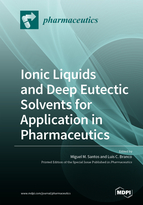Ionic Liquids and Deep Eutectic Solvents for Application in Pharmaceutics
A special issue of Pharmaceutics (ISSN 1999-4923). This special issue belongs to the section "Physical Pharmacy and Formulation".
Deadline for manuscript submissions: closed (31 May 2020) | Viewed by 39374
Special Issue Editors
Interests: development of sustainable chemistry and applied functional materials; including ionic systems-based ionic liquids and eutectic solvents for sustainability
Special Issues, Collections and Topics in MDPI journals
Interests: active pharmaceutical ingredients as organic salts and ionic liquids; API-OSILs; bioavailability; drug delivery; ionic liquids
Special Issues, Collections and Topics in MDPI journals
Special Issue Information
Dear Colleagues,
Over the last decades, Ionic Liquids (ILs) and Deep Eutectic Solvents (DES) have been studied academically throughout many fields of chemical and biological research, including pharmaceutical sciences, due to their highly tuneable physical, chemical and physicochemical properties. In the particular area of pharmaceutics, ILs have been studied as alternative green solvents for the preparation, purification and crystallization of active pharmaceutical ingredients (APIs). However, the tailorable properties of ILs and DES render them distinct interactions with cellular membranes and organelles, enabling a myriad of applications ranging from bactericidal agents against pathological microorganisms to innovative materials for transdermal drug and protein delivery. ILs and DES have also found use in the manipulation of naturally occurring matrixes such as polysaccharides, yielding outstanding materials suitable for tissue regeneration and wound healing, as well as gene and drug delivery. Furthermore, the formation of ILs by combination of ionisable APIs with biocompatible organic counter-ions (API-ILs) has shown striking evidence over the last decade as a very capable instrument to enhance the bioavailability of poorly water and/or lipid soluble drugs, in addition to reduce or even eliminate polymorphism, yielding more effective formulations of commercial drugs.
In this Special Issue we focus on revealing fascinating developments covering all applications of Ionic Liquids and Deep Eutectic Solvents in pharmaceutical sciences.
Dr. Luis Branco
Dr. Miguel Santos
Guest Editors
Manuscript Submission Information
Manuscripts should be submitted online at www.mdpi.com by registering and logging in to this website. Once you are registered, click here to go to the submission form. Manuscripts can be submitted until the deadline. All submissions that pass pre-check are peer-reviewed. Accepted papers will be published continuously in the journal (as soon as accepted) and will be listed together on the special issue website. Research articles, review articles as well as short communications are invited. For planned papers, a title and short abstract (about 100 words) can be sent to the Editorial Office for announcement on this website.
Submitted manuscripts should not have been published previously, nor be under consideration for publication elsewhere (except conference proceedings papers). All manuscripts are thoroughly refereed through a single-blind peer-review process. A guide for authors and other relevant information for submission of manuscripts is available on the Instructions for Authors page. Pharmaceutics is an international peer-reviewed open access monthly journal published by MDPI.
Please visit the Instructions for Authors page before submitting a manuscript. The Article Processing Charge (APC) for publication in this open access journal is 2900 CHF (Swiss Francs). Submitted papers should be well formatted and use good English. Authors may use MDPI's English editing service prior to publication or during author revisions.
Keywords
- Ionic Liquids (ILs)
- Deep Eutectic Solvents (DES)
- Drug Delivery
- Drug Bioavailability
- Polymorphism
- Cytotoxicity
- Pharmaceutical Ionic Liquids (API-ILs)
- Therapeutic Deep Eutectic Solvents (THEDES)








